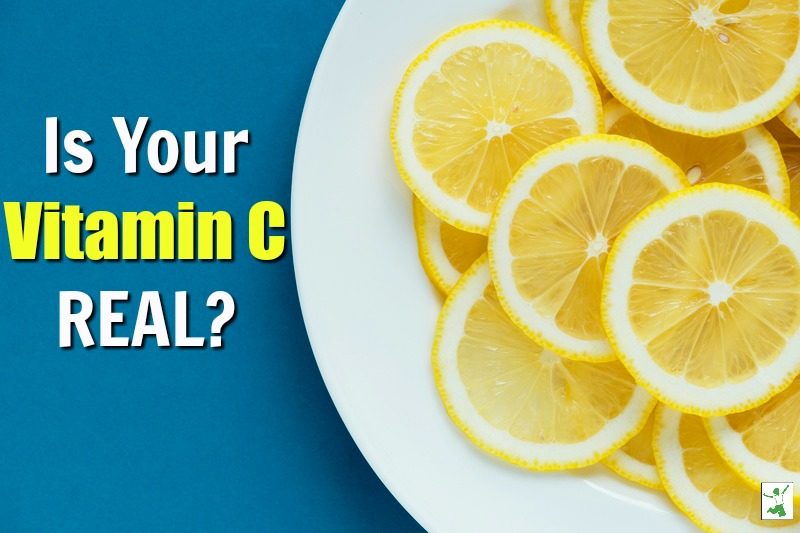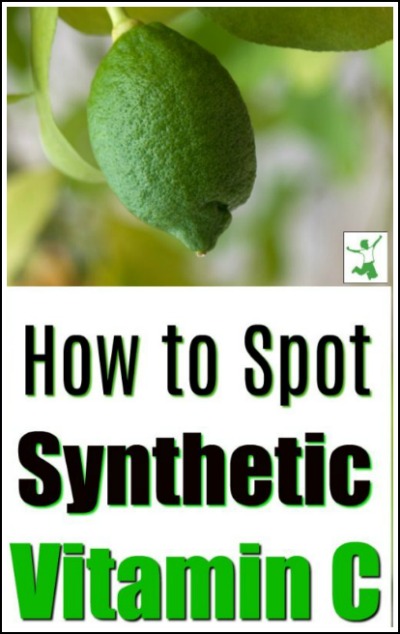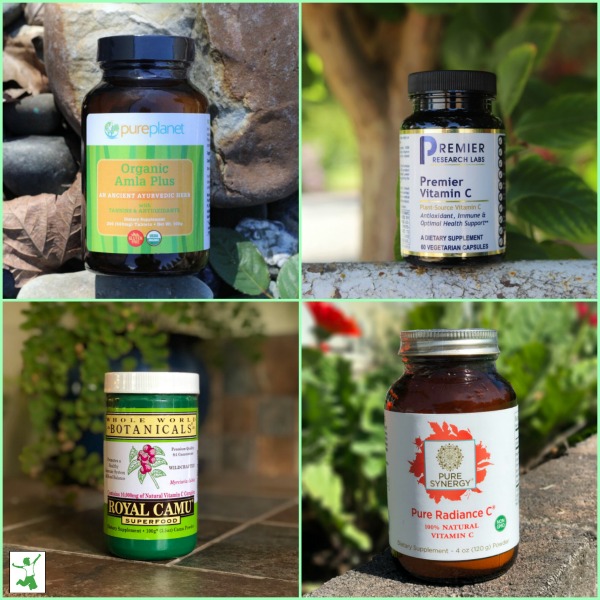Table of Contents[Hide][Show]

Did you know that ascorbic acid is actually synthetic vitamin C? What’s more, it is usually GMO vitamin C, which means it was derived from GMO corn.
If you are learning this for the first time, it can be a rather shocking realization as almost all vitamin C supplements on the market use isolated ascorbic acid separated from a whole food source. The manufacturing process that produces synthetically derived vitamin C leaves all the beneficial co-factors behind!
Even more disturbing, ascorbic acid is frequently marketed as natural vitamin C and added to organic foods as a natural preservative. Truly natural forms of vitamin C and synthetic ascorbic acid seem to be used interchangeably.
How confusing for the consumer!
Nearly all juices and fruit products are loaded up with ascorbic acid, even many organic, healthfood store versions. It seems that if a product is labeled “high in Vitamin C”, consumers buy more of it.
A lot of folks are being fooled by these misleading semantics. There is a growing body of evidence that those consuming high doses of ascorbic acid should have reason to worry.
Three Studies Suggest Caution with High Dose Ascorbic Acid
The journal Wise Traditions cites three studies that give pause about large doses of vitamin C. The first, from the Jun 15, 2001 issue of Science, showed that “synthetic vitamin C may contribute to the formation of genotoxins that can lead to cancer”.
A second study presented to the American Heart Association showed a link between consumption of only 500 mg of vitamin C per day and a greater propensity toward thickening of the arteries (Los Angeles Times, March 3, 2000).
More recently, athletes taking 1000 mg of isolated ascorbic acid per day showed reduced endurance capacity from interference with antioxidant enzymes (American Journal of Clinical Nutrition, Jan 2008).
This information should give pause to anyone who is actively taking synthetic vitamin C supplements such as those Emergen-C packets that are available everywhere, from pharmacies and health food stores to even gas stations!
Supplements like these are NOT boosting immunity and are NOT good for you!
Synthetic vitamins such as ascorbic acid act more like drugs in the body rather than whole food nutrients with all the available co-factors. Taking any synthetic vitamin can cause imbalances in the body and should be avoided.
Another worrisome and popular trend is the recommendation of some alternative health professionals to do a “vitamin C flush” during illness. This therapy (if you can call it that) calls for large doses of ascorbic acid until the onset of diarrhea.
This approach to regaining wellness has never made any sense to me. Now, with more studies indicating the danger of high doses of vitamin C, caution seems well-founded.
Fan of Linus Pauling? Consider This…
If you are a fan of Linus Pauling who popularized the notion of huge doses of Vitamin C for the common cold in the 1970s, consider this. GMO Vitamin C did not exist when Pauling was conducting his studies. GMO derived Vitamin C is what most people are unwittingly taking today!
What’s more, the studies indicating the danger of high doses of vitamin C over long periods of time had not been done yet. They were conducted long after Pauling died in 1994.
What about High Dose, Intravenous Ascorbic Acid?
What about high dose, intravenous ascorbic acid for the very ill? Note that vitamin C for IV use is almost always derived from GMO corn as well as being extremely high dose and synthetic ascorbic acid only.
Under certain circumstances and for the very ill, high dose GMO ascorbic acid therapy can be beneficial. For example, my husband used IV ascorbic acid therapy immediately after each amalgam removal. This prevented any released mercury from getting stored in the tissues. Not doing this risks the development of autoimmune disease.
However, synthetic vitamin C especially when genetically modified shouldn’t be a regular feature in anyone’s diet or supplement regimen.

Whole Food Vitamin C is Naturally Low Dose
The best way to get vitamin C on a daily basis is from whole foods sources. This will provide you this critical nutrient at a low dosage that will do no harm over the long term.
When you get the whole foods version of vitamin C, you don’t need much at all. A truly natural vitamin C supplement with no isolated ascorbic acid is naturally low-dose and yet highly effective.
Don’t forget about the benefits of fresh grassfed milk – a great source of vitamin C. The vitamin C in milk is mostly destroyed by pasteurization, along with many other nutrients. This is why buying fresh and local is so important.
Fresh and lacto-fermented fruits and vegetables (such as traditional sauerkraut) are other excellent sources of the whole vitamin C complex.
Perhaps folks feel the need to take large doses of synthetic vitamin C because all the processed foods they are eating are so devoid of the nutrient in its whole form. Switching to whole foods and dumping those vitamin C supplements in the trash would be a much better approach to boosting immunity!
Ascorbic Acid is Usually from Genetically Modified Corn
What’s worse is that ascorbic acid is not just synthetic. Remember that it is also usually derived from genetically modified corn! More on that GMO vitamin C travesty fooling millions of consumers every single day in the linked article.
Another vitamin scam harming consumers concerns synthetic folate commercially known as folic acid.
The pushing of beta carotene as true vitamin A by food manufacturers and supplement companies is another nutritional falsehood scamming millions of consumers and worse, seriously harming their health.
What to Look for in a True Vitamin C Product
To give you some idea of what to look for in a vitamin C supplement, here are the ingredients of the one I use. Notice that there is no isolated ascorbic acid or other ascorbates and no additives. Just pure food Vitamin C sources. Please note that this is not the only Vitamin C supplement that qualifies as totally pure. There are a few others.
Pure Radiance C ingredients: camu camu berry extract, manioc root, acerola berry extract, amla berry extract, buckwheat sprouts, freeze-dried berry blend, blueberry, raspberry, cranberry, cherry, rose hips fruit, lemon peel, black pepper berry extract.
I also use the Amla C Plus. Here are the ingredients: Organic Amla berry, organic spirulina.
Notice that the words “ascorbic acid” are not listed in either of these products!
Want to know where to find a complete line of whole food Vitamin C supplements from a variety of whole food plant sources?
Click here for several carefully vetted brands to choose from.









hi
I use ascorbic acid in prevention of discolorations in yam and this is because I produce in large quantity so if all have read is true than am going to need your help Sarah. as much as I do healthy eaten for but above all make sure people are safe when they buy my product. so since ascorbic acid not healthy what else can I use that healthy
There are other antioxidants used as natural preservatives in food manufacturing that are safer than ascorbic acid. I’ve seen products that use rosemary oil, grapeseed extract or Vitamin E. There are probably others as well.
This entire article contradicted itself. How can you say that something is dangerous while also saying that it healed your husband and can be very beneficial for the very I’ll? To me, it sounds like this product may be more beneficial to than not if it was able to help your husband avert a crisis.
There’s a difference between using a therapy for a severe situation and using it everyday as a vitamin supplement. That’s not contradictory at all! It’s being aware of the gray areas and realizing that some things such as gmo vitamin C are used only for dire emergencies. Also, hopefully a nonGMO high dose ascorbic acid IV will come out someday, then those of us who know the dangers of GMO vitamin C can choose that instead if we ever need that type of therapy. That at least eliminates one of the major problems with ascorbic acid.
I was curious aout your claim. So I investigated it and found this from the respected Linus Pauling institute:
lpi.oregonstate.edu/mic/vitamins/vitamin-C/supplemental-forms
I enjoy following your YouTube channel and came across your blog here while researching ascorbic acid vs natural C. I’m a nutritionist of 30+ years and I bought in to all the supplement hype (as most of us did in 70’s and 80’s when it was stressed how depleted our soil is… by the supplement industry, lol!)
First, I’d love to see your references to the studies – not in a snarky way, lol, but genuinely. I followed your link to the Wise Traditions site and then searched for the article citing the three studies but nothing came up. Since you’re researching anyway, could you include your references which are especially helpful for professionals?
Next I wanted to mention my favorite source for vitamin C is camu camu powder which provides about 700 mg if vitamin C per 1/4 tsp. But there are not many good sources. I use either Healthworks brand or bulk from mountain rose herbs. (No connection to either.) Brands like Navitas are heavily processed for better flavor and solubility and therfore best avoided. (Camu should be a tan/brown powder, not bright pink like Navitas and others.) Also watch out for the unknown brands selling “certified organic” camu on Amazon, not one was able to provide either a COA or proof of organic certification when I contacted them last summer. (Except Healthworks and Mt Rose which provided both.)
But I question how long it takes for the vitamin C in the camu (or acerola berries) to breakdown once harvested since vitamin C is very unstable? Any thoughts here or do you know of any studies?
Also, one person commented he takes acerola with some baking powder to negate the acid. I’m wondering if either acerola or camu produce an acidic or alkalizing effect? Perhaps it is depends on how much it’s been processed. Generally eating an orange or a lemon is thought to produce a metabolic alkalizing effect. But there’s a lot of debate on this – I’d love to know your thoughts.
Finally, eating food-sourced doses of 50mg has shown no increase in blood plasma levels of vitamin C. Does that mean it’s useless? No, it’ll certainly prevent scurvy – but fend off a cold? Probably not.
When I first feel a cold coming on I still reach for ascorbic acid, about 2000 mg every 3 or 4 waking hours along with my other herbs. It works great through its cytotoxic effect. But studies show it can have adverse effects taken long term as you pointed out (as anything cytotoxic certainly will – think taking low-dose chemo drugs long term). I agree that a daily, safer, form is advised. But again, is a mere 30 mg from an acerola tablet meaningful or a waste of money?
Next time I feel a cold coming in I’m going to try dosing up on camu camu instead of ascorbic acid to see if it’s as effective – maybe 1/4 tsp (700 mg) instead of my usual 2000 mg ascorbate. Some say natural vitamin C is more effective at lower doses because it is more bioavailable. We’ll see. ????
Hi Sarah – this is great information thank you! I’m wondering if it’s safe to use the synthetic vitamin c externally, such as a facial toner, rather than ingesting it? I have found the pure radiance food source vitamin c isn’t ideal for dissolving in liquids to create a toner, and I’m looking for alternatives to buying a $50 serum with a ton of additives. Thanks for your time!
I think that would be fine. I haven’t seen any research suggesting that externally used ascorbic acid is a bad idea like with internal ingestion of synthetic C. Just be sure it is nonGMO else there would likely be pesticide residue which you would not want on your skin.
For your information: Even tho natural C and ascorbic acid has an identical chemical formula, the nucleus is not the same. Therefore, they are not identical! G.M.O. C refers to Monsanto’s corn/corn sugar that is used by factories to manufacture the man made ascorbic acid.
Hi Sarah,
I’ve been counseled by my GAPS practitioner to make my own liposomal vitamin C. Could you apply your research skills and suggest good sources for the ingredients?
Thank you!
Laura
What is the brand of the chewable vitamin C you have used for your children? Thanks.
By giving your children just 30 mg of vit. C, you are protecting them from scurvy well. However, to protect against the cold or flue, you’d better buy a few kilograms of ascorbic acid and do what dr Cathcart did and many others (including me). Almost all animals use mega doses of ascorbic acid (pure, with no “natural cofactors” whatsoever), because it’s produced by their livers (nothing to do with eating fruits etc., so don’t even try to get such high doses from food). Humans, on the other hand, must rely on synthetic ascorbic acid from GMO corn. Fortunately, it’s exactly the same chemical substance as from organic acerola. Just make sure to rinse your teeth, so that enamel isn’t damaged too much. Any other possible “side effects” are almost certainly less harmful than suffering from infections or allergies.
Where can we buy Whole IV Vit C instead of ascorbic acid?
Links to vetted brands are included in the article.